Engravings of the year 1622
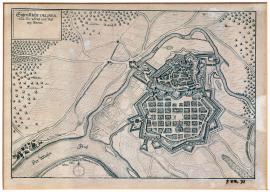
The actual drawing of the town and fortress of Hanau.
The schematic illustration of the town of Hanau, which lies close to the river Main, about 20 kilometers west from Frankfurt. A small river Künzig flows around the town. In the landscape, few individual trees are drawn. In the left top corner, there is a rectangle with an inscription above, without a given time and specification. Also, the image does not show, except for three cannons located in the town square, any military motives.
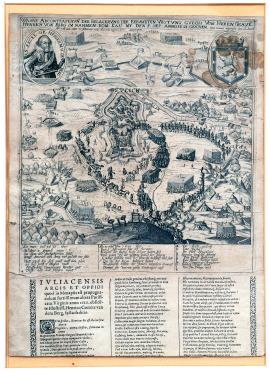
True depiction of famous Gulch (Jülich) fortress, besieged by Count Henry of Berg from 5 September 1621 in the name of His Imperial Majesty, abandoned on 12 December and conquered upon agreement on 3 February 1622.
The engraving is quite crude. In the centre, there is the Jülich fortress with troops marching around and enemy units leaving the town. Wide neighbourhood of the city is dotted with various chances, fortifications and military camps. A hill will gallows on top is in the foreground. A portrait of Henry, Count of Berg is in the left upper corner, on the right, there is a coat of arms with a lion. German description of the situation with marking of camps of Berg and Spinola is below the painting on the board. Under it, there is a detailed description of the event in Latin, which celebrated the heroism and credit of general of Berg.
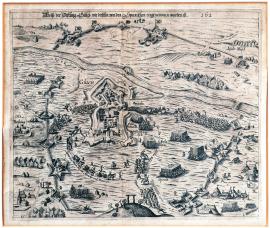
Drawing of Jülich fortress, which was conquered by Spaniards. 162.. (1622).
The painting shows the Jülich fortress and city near the Dutch borders with its surroundings. The upper part of the painting shows the Roer (Ruhr) river, a wide circle of fortifications, chances and various fortification objects, military camps, movements of military units etc. A hill with gallows is in the foreground. Some settlements in the area are marked with names.
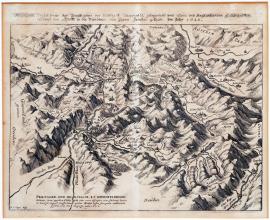
True drawing of Pratigov in Meyefeldst estate, which lies around Chur, and surrounding lands; battle of Pündtners against their enemies. In 1622.
We can see a hilly Swiss country with the Rhein river and Chur city, near which is a battle of armies, which come from all directions. Cities and villages are named. Territorial borders are marked with dotted line. Below the painting, there is the aforementioned text.
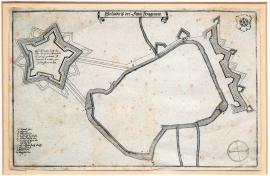
Plan view of Hagenau
It is a schematically drawn city plan without figures and any staffage. In the right corner, there is a city coat of arms with a rose, on the left, there is a fortress founded by Mansfeld, which was subsequently closed down. Under the painting, there is a legend.
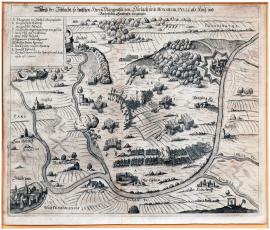
Sketch of the battle, which happened between Margrave of Baden-Durlach and Tilly, the Imperial and Bavarian General.
The engraving is done (superficially and apparently hastily) in the manner of maps; streams are drawn as in reality. Cities and villages are marked with their names. Heilbronn at the bottom left and Wimpfen at top right. The explanatory notes A to L contain explications of the depicted events. In the middle of the engraving, there is a distinguishable wagon fortification with the mark 'D'. There is the inscription above: 'Palatinatus', and: 'Pars Ducatus Würtenbergensis' is below.
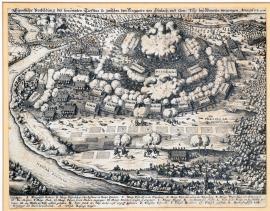
The actual illustration of the famous encounter of Margrave of Baden-Durlach and General Tilly in the Battle of Wimpfen on 7 May 1622.
The engraving shows the progress of the battle in the clouds of blowing dust and smoke from exploding ammunition supply. On the left, there is the river Neckar and the Böllinger stream in the background, which as a natural obstacle caused catastrophic losses to the army of Margrave of Baden-Durlach during their escape. The town of Wimpfen is at bottom right. The battle wagons are clearly visible in the Protestant position. The given inscription is above the image, the explanatory notes A-R are below.
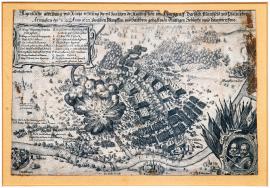
Actual depiction and short report of a bloody battle and the main clash of imperial forces on one side and Margrave of Durlach, Mansfeld and Palatine armies on the other side, which occurred between Wimpfen and Hailbron on 26 April/6 May 1622.
In the right bottom corner of the engraving, there is a double portrait of Tilly and Corduba in an oval cartouche. The print also shows the flow of Neckar, town of Wimpfen and panorama of the battle with an explosion of ammunition of Margrave of Durlach. Above the painting, there is the mentioned text, an A–R legend is below the painting.
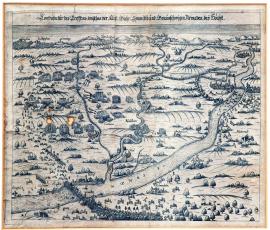
Depiction of battle between the army of Elector of Bavaria, Spanish army and Brunswick army near Höchst.
The engraving shows a well-arranged map of the entire battlefield. The Main river, which flows through Frankfurt and Sachsenhausen, flows through the map diagonally; the town of Höchst with a bridge over Main, on which the defeated Brunswick army crowds, lies near the mouth of the Nidda river on the right shore of Main. Several castles and settlements, which are marked with names, are in the background in hilly terrain.
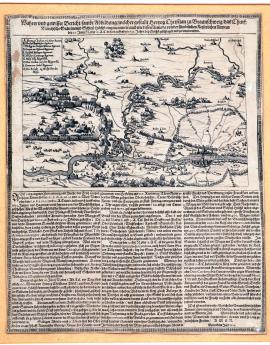
True and certain report with depiction of how Christian, Duke of Brunswick captured Höchst, electoral town of Main, and how his army was defeated and disbanded by all the imperial armies on 20 June of the new calendar, or 10 June of the old calendar, in 1622. Printed in 1622.
The painting shows landscape near Höchst and Frankfurt. The Nieda river joins Main near Höchst. On the left, there is the ongoing battle, the defeated army of Christian Brunswick retreats over the bridge over Main. Large column of imperial forces is approaching from Frankfurt. In the left corner of the sheet, there is an A-K legend and on the bottom, there is a German text, describing the course of battle in detail and all relevant facts.
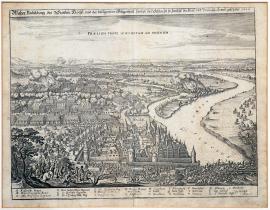
True depiction of the town of Höchst and the surrounding landscape with battle between the imperial and Brunswick army, which took place in 1622.
The town of Höchst is in front of us, on the right, there is a wide river, Main, over which the armies of Duke of Brunswick are fleeing; behind the town, the battle is in full progress yet. Fitting perspective and perfect engraving technique reminds of Václav Hollar. However, the engraving is not signed. Under the pictorial part of the print, there is an A–Z legend.
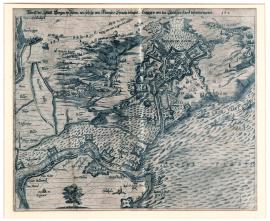
Drawing of city of Bergen op Zoom, which was besieged by Ambrogio Spinola, 1st Marquis of the Balbases and strongly defended by the townspeople. 1622.
The city of Bergen op Zoom is depicted from above, from the so-called bird's-eye view. In the surroundings, there are various Spanish battle structures, which served for approaching and storming the city. The town of Sternbergen is foreshadowed in the upper left part. Probably artificially created floods of the river Scheldt, which were supposed to be an impassable obstacle for any enemies, are extraordinary. Above the painting, there is the mentioned text.
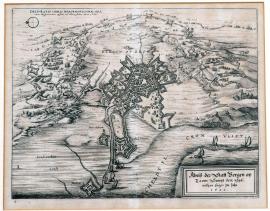
Drawing of the city of Bergen op Zoom with the Spanish camp from 1622.
The fortified city of Bergen op Zoom is in the centre of the painting. The land around the city shows chances of besieging Spaniards, camps, tents, positions of military units, marching regiment and several banners. The river Scheldt is swollen around the city. There is a Latin inscription above: „Delineatio urbis Bergenobsooma una cum hispanorum castris ad illam factis, anno 1622.“ German text is under the painting on the right. On the left, there is a writing on the water: „Verdroncken Landt – i.e. flooded ground“. To fortify the city, his surroundings were flooded.
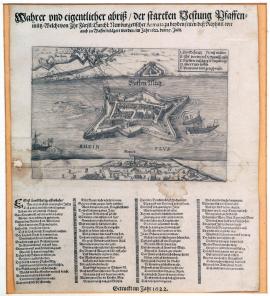
True and real drawing of strong fortress Pfaffenmütz, which was besieged by Neuburg army on both sides of Rhein, as well as on the water, on 25 July 1622. Printed in 1622.
Wide Rhein river flows through the centre of the painting, we can see the heavily fortified island of Pfaffenmütz. Two ships sail on Rhein. Lower on the Rhein, there is a village of Rindorb (Rheindorf), Berchen is on the upper left. In the right upper corner of the painting, there is a legend with letters A–H. Above the painting, there is the mentioned text, below the painting, there is a four verse long German poem which describes the course of the siege.
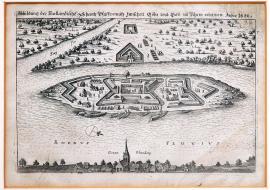
Depiction of Dutch fort Pfaffenmütz between Cologne and Bonn on Rhein. 1622.
The small painting portrays the fortified island of Pfaffenmütz in the middle of Rhein. In front of us, there is the village of Graen Rhindorf (correctly Gross-Rheindorf). Small stream Sieg joins Rhein. On the left side, in landscape covered in trees, there is a settlement called Berchen.
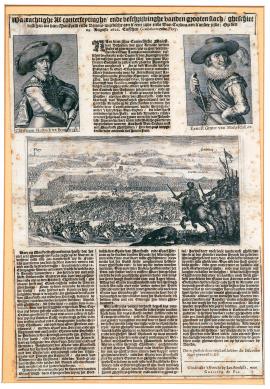
Depiction of battle between Ernst von Mansfeld and Christian, Duke of Brunswick-Wolfenbüttel on one side and Don Corduba on the other side, between Flory and Gemblours in Belgium on 29 August 1622.
The mentioned Dutch text is at the upper side of the sheet. Portraits of Ernst von Mansfeld and Christian Brunswick are below. They both have large hats and marshal batons. The portraits have dimensions 6 x 9.5 cm and they were engraved by S. de Passe. The lower half of the sheet contains a painting of the actual battle. In the right front, there are riders with banners with dead horse nearby. The main scene of the painting is the cavalry attack lead by Duke of Brunswick, who decided the battle in his and Mansfeld's favour by this decisive attack of his. At the horizon, town of Flory is on the left and town of Gemblours is on the right. Under the painting, there is an extensive Dutch text concerning the course of the battle.
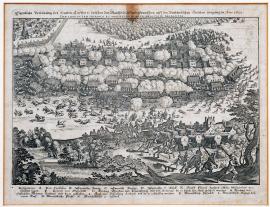
Actual depiction of severe fight which occurred between Mansfeld and Spanish (armies) on Brabant borders. 1622. Battle between Spanish and Mansfeld's (armies) near Fleurus in Brabant duchy.
The engraving shows the battle of Fleury on 29 August 1622. In the front, we see Mansfeld's retreating army, in the middle, the fight is in full progress. On the left, there is a depiction of an attack of cavalry of Duke Christian of Brunswick, who, even though he was wounded on arm, had decided this battle in his favour, because it was a draw for a long time and Mansfeld's units were already partially retreating. In the end, Spaniards were defeated. The horizon of the landscape is a forest. In the front of us on the right, there are three fleeing musketeers of Mansfeld. Under the painting, there is an A–N legend.

The siege and conquest of the town and fortress of Mannheim in 1622.
This is a schematic plan of the town of Mannheim with the river Rhine into which the Neckar flows. The landscape is studded with trees, which are all equally carved. The fortress of Mannheim is drawn without the construction details, just fortified facilities are carefully drawn up. Around the area, there are scattered individual soldiers and lines of shooting musketeers.
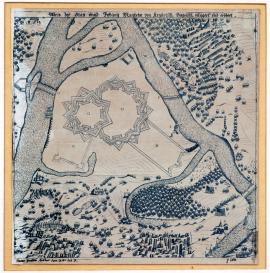
Sketch of the city and fortress of Mannheim, which was besieged and conquered by the imperial and the Bavarian (troops).
In the middle of the image, there is a schematic drawing of the fortress of Mannheim with the rivers Rhine and Neckar. In the surroundings of the city, there are deployed cannons and many trees with spherical treetops. Explanatory notes A-T under the image are missing (cut off).


